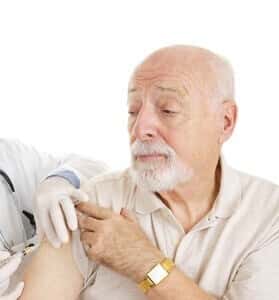
How effective are flu shots? The influenza virus changes from year to year, and consequently the vaccine must change as well to keep up. This means that experts need to study vaccination effectiveness every year to be able to tell how well the immunization programs are working. We suspect that most parents do not know what the actual effectiveness is from year to year. And chances are good that they don’t know the kind of flu shots their children receive either at the doctor’s office or the local pharmacy. That could be crucial information as the article below points out.
Disappointing Results from Last Year:
An analysis of the results from the 2015-2016 flu season has just been published in The New England Journal of Medicine (Aug. 10, 2017). The researchers used data from the Influenza Vaccine Effectiveness Network, which kept records on children older than 6 months who showed up with respiratory infections that season.
The news is not good. The live attenuated quadrivalent vaccine that was expected to provide powerful protection against influenza was ineffective in children.
Overall, vaccine effectiveness was 48%. That included inactivated influenza vaccine, which performed significantly better.
A History of Flu Shots:
This is not the first time the live attenuated flu vaccine proved disappointing. During the winter of 2013-2014, the live attenuated vaccine was also ineffective in children. The Advisory Committee on Immunization Practices [ACIP] did not recommend the use of live attenuated vaccines last year.
Overall Vaccine Effectiveness in Past Years:
The CDC keeps a record of how effective flu shots are from year to year. Some people see the glass as half full. We are not so charitable. Here are the results from the CDC’s website:
2004-2005: Vaccine Effectiveness was: 10%
2005-2006: Vaccine Effectiveness was: 21%
2006-2007: Vaccine Effectiveness was: 52%
2007-2008: Vaccine Effectiveness was: 37%
2008-2009: Vaccine Effectiveness was: 41%
2009-2010: Vaccine Effectiveness was: 56%
2010-2011: Vaccine Effectiveness was: 60%
2011-2012: Vaccine Effectiveness was: 47%
2012-2013: Vaccine Effectiveness was: 49%
2013-2014: Vaccine Effectiveness was: 52%
2014-2015: Vaccine Effectiveness was: 19%
2015-2016: Vaccine Effectiveness was: 47%
2016-2017: Vaccine Effectiveness was: 42%
Overall Effectiveness: 41%
According to our calculations that means the average annual vaccine effectiveness over the last 13 years is right around 41%. We find that less than reassuring. It means that more than half the time flu shots don’t work. We wonder whether most people who sign up (and pay for) flu shots realize that their odds of being protected are less than 50:50 in most years.
Stories from Readers:
What does that mean in practical terms. We find it helpful to share stories from readers to put the stats into human context.
Helen in Illinois was not protected in 2016:
“I got my flu shot as I do every year. I got sick, was hospitalized for 2 days with a diagnosis of a deep, painful cough, dehydration, low potassium, low oxygen, Influenza A and pneumonia. I was also hurting for several days from the shot. Yes, the CDC messed up this year with their vaccines. Hope it doesn’t happen next year. I can’t afford to get sick, I have a loved one to care for.”
Tessa in Massachusetts reported on her child’s experience:
“My 5-year-old daughter got a flu shot and now she can’t fall asleep because she says her armpit hurts. I decided to search online for a connection between this pain and the flu shot, and I’ve come across a few websites like this one.
“I am really upset by this. Last year when she got the flu shot she was sick with flu-like symptoms for a week. I chalked it up to a coincidence, but now I’m not thinking so and I wish I had followed my gut and not let her get it again this year!
“She says it hurts and nothing helps. She keeps begging me to ‘find something to fix it’ so she can sleep.”
Melanie in Oregon also had a painful armpit:
“My first negative reaction to flu vaccine happened last week when my husband and I got our flu shots at a local pharmacy. I awoke with a swollen lymph node under my left arm which was very painful and restricted my arm movements.
“Over the next few days, the swelling decreased and the pain lessened leaving a ‘palm size’ swollen arm pit but range of motion increased and each day it is better. When I read others’ negative reactions to this year’s vaccine, I feel fortunate to have a much lesser result. I hope this vaccine at least protects against the FLU. What a concept! Prayers for those recovering from the vaccine itself.”
The Bottom Line from The People’s Pharmacy:
We certainly hope that this year’s flu shots are more effective than they have been in the past. We are not holding our breath, however. Based on the article in the New England Journal of Medicine we would probably discourage use of the live attenuated flu shots in kids. Here is the conclusion from the Journal article:
“During the 2015-2016 influenza season, the quadrivalent live attenuated influenza vaccine was found to be ineffective against A(H1N1)pdm09 in children, whereas there was substantial effectiveness of the inactivated influenza vaccine… Although the quadrivalent live attenuated vaccine remains licensed in the United States, the ACIP [Advisory Committee on Immunization Practices] did not recommend this vaccine for the 2016-2017 influenza season.”

